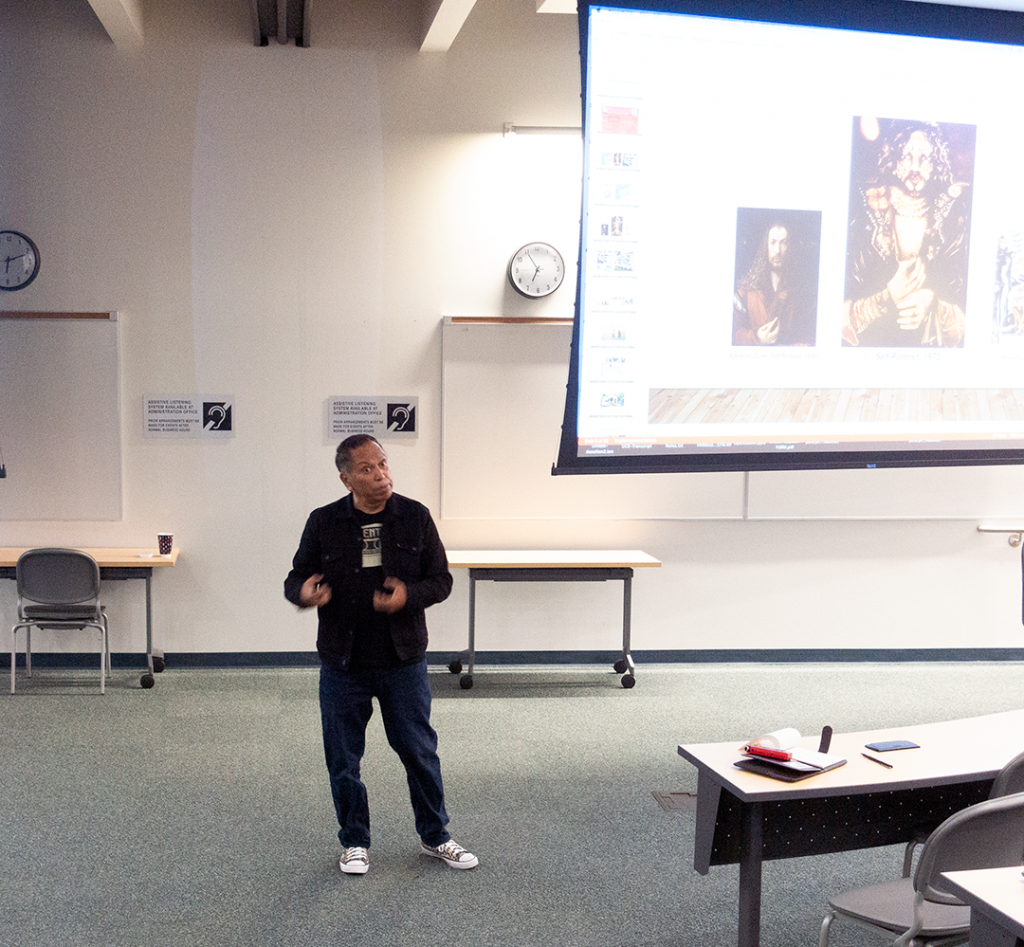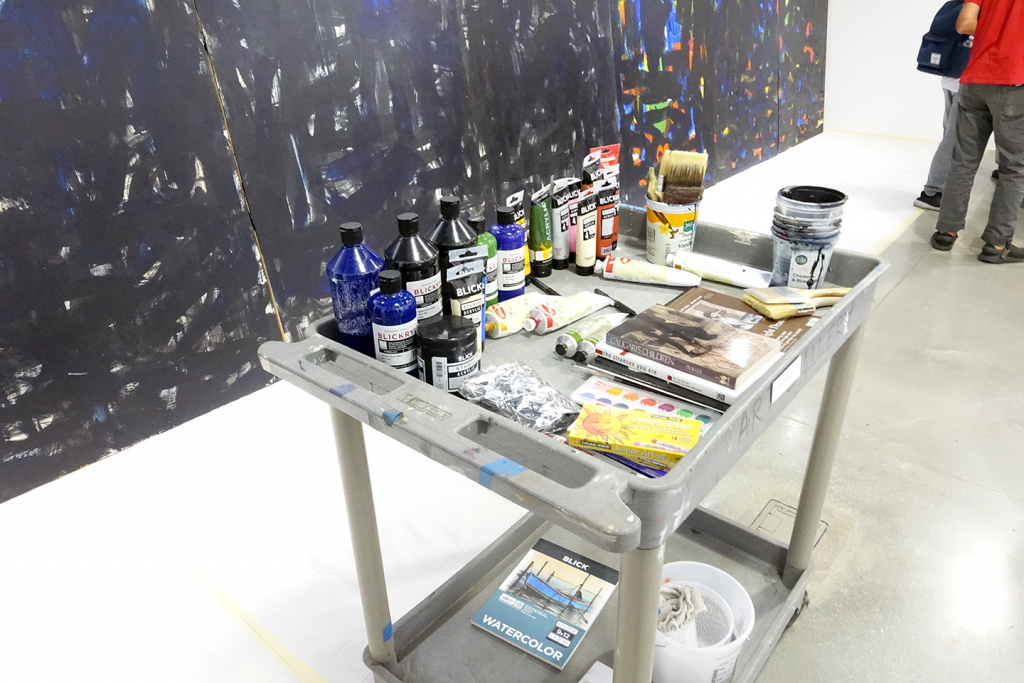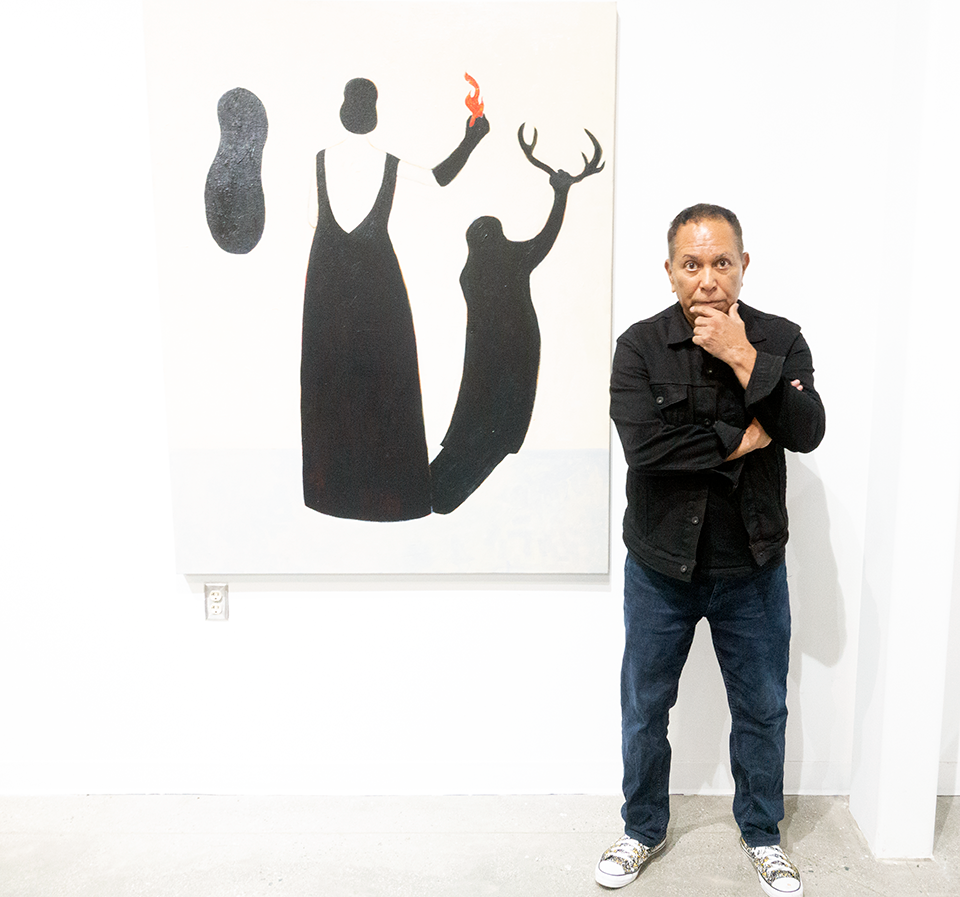By Keith Walsh
Growing up in East Los Angeles in the 1960s, Gronk (Glugio Nicandro) fed his imagination reading philosophy and finding poetry in Hollywood B movies. Inspired by his mother, an artistic uncle, and influential educators in middle school and high school, he discovered a passion for painting, printmaking, photography and other visual arts. From early stunts by the collective ASCO, through his 1984 installation for MOCA in Los Angeles and up to the present day, Gronk has created works for galleries, public spaces, and stage, including collaborations with The Kronos Quartet and opera director Peter Sellars. I visited Gronk at Cerritos College this week, where he discussed his life and work, on display in the Cerritos College Art Gallery through September 30, in an event hosted by Professor James MacDevitt, the gallery’s director. Titled “Stock Footage And Outakes: A Selection Of Works By Gronk,” it’s part of the project SUR:Biennial, which was founded in 2011 at Cerritos College and Rio Hondo college, and has 16 exhibitions at various locations in Southern California this year.

Accompanied by a PowerPoint presentation, Gronk started out by talking about his first public art presentation — a performance piece. “This was called Caca-roaches Have No Friends – and indeed they don’t,” Gronk said. “It was done at a park in East Los Angeles. I was a teenager at the time, and I wrote this play, it was kind of like The Origin Of Species. People were rolling around on the floor on the stage, in plastic bags, so they were like amoeba and protozoa. And I got a very interesting reaction. Because I had advertised it as a children’s puppet show. And indeed it was not.” The show featured one of Gronks friends as a drag queen and had elements of theater of the absurd. “So theatricality has always been a part of my work,” Gronk said. “If you look at my drawings, if you look at my paintings, there is a theatricality to it all.”
Gronk said that early on in his career, “I thought of myself as more of a performance artist. It was at a time where performance art was beginning to unfold. Painting came a bit later in my life, as a serious painter. That didn’t come till the 80s.”
He talked about his inspirations. “(One)thing that has a big influence on me –and kind of a ridiculous influence, is B movies. Particularly B movies from the 50s.” Gronk mentioned Devil Girl From Mars as a film that sparked his artist’s imagination early on. “Ridiculous, stupid, all of that – but yes, I loved it.”
Finding poetry in absurd dialogue, His painting Awake, Martha, Awake was inspired by Attack Of The Crab Monsters, a line spoken by a talking ashtray. “To me, that was poetry – an ashtray that talks,” Gronk said. “So I pull that, and several titles in the show are Awake, Martha, Awake…Another one was ‘I Feel Like A Brand New Toothbrush’– and that one was from This Island Earth. So it’s taking the poetry that I would find in B movies and incorporating that into my body of work.”
Gronk got a chance to practice some painting skills in 1973 when he joined Los Angeles artist Willie Herrón III in the creation of a mural. “Willie was asked to paint a mural in East L.A….I was considered just an absurd teenager who was doing things that other people were not doing, and Willie was the painter. So everybody kind of gravitated to his style. But I wanted to do a mural in black in white…because all of the other murals that I would see were in vibrant color. So this one was kind of like a film noir. And it was taken from visual imagery in the neighborhood where I grew up. Estrada Courts were nearby. The police would come in and tear gas people when they had a moratorium against the Vietnam War, so I decided to include in the imagery this character, who is in the piece. And his name is Baptiste. He is a character from the movie Children Of Paradise. Children Of Paradise was made in the forties when the Germans occupied France. So there was a sense for me that, ‘well, East L.A. is being occupied by the sheriff’s department, so I wanted to link it historically.’ Most people never ever saw that, except when a French film director came and said ‘that’s from Children Of Paradise,’ — she would know, she’s from France.”
‘Coffee And Donuts’
In 1984, Gronk finally had a chance to be seen by large gallery crowds when MOCA asked for his participation in a show. He explained: “They asked ‘what would you like to do? You’re the person who does dinner parties at traffic islands, you tape people to walls, you do journals and drawings and books – you can do whatever you want to do.’ Now a lot of artists at that time were the favorite artists that everybody wanted in this show. So the galleries were pushing ‘get Mike Kelly, get (Richard) Pettibone, get all of these different people that people knew about.’ But I was picked. Everybody asked ‘how did he end up at MOCA?’”
“Out of my mouth came the words ‘I want to do a mural the size of a football field,’ 300 feet by 30 feet high.’ Gronk told them it would take two weeks. “I had no idea.” When asked what he needed to complete the task, he said ‘a lot of coffee and a lot of donuts.’ But I did the painting, the size of a football field, and all of sudden (it’s) ‘New Painter In Town.’ That was kind of like the reviews of the time. ‘New painter, where did he come from?”
Then galleries began calling, sparking Gronk’s determination. “And all of a sudden I was placed into the realm of producing artwork, a lot of artwork. And the gallery was successful in selling my work, and I decided I have to learn –really- how to paint. I decided I was going to be more diligent in doing my art work and my art practice, if I’m ever going to call myself a painter. Because at the time I never even thought of myself as a painter.” Along the way, Gronk picked up degrees at Los Angeles College and Cal State L.A.
Gronk talked about his 1984 work Cabin Fever, which is an allegory featuring party revelers on a ship that’s going down, as a metaphor for the GOP at the time. Sometimes people wonder about a perceived lack of political content in Gronk’s work. “Well, you’re not really looking at my work,” he explains. “It’s subtle. It’s in the background. There’s something in there. There is also humor. It’s called irony. Irony is a part of my language. It’s part of using the B movie. It’s part of using classical books, as a part of my ammunition to create.’
In the 1990s Gronk created a series of paintings based on his appraisal of the Hotel Senator in DTLA. “I love the fact that it was called Hotel Senator,” he says, “because it was a house of prostitution and drugs….so I’m going to run across the street, steal the sign that says Hotel Senator, and said ‘this is an ugly looking sign. So I’m going to do my paintings as ugly as I can do.’ Wars are raging, things are going on here in the United States, and I do this show, but nobody wants it. Collectors, everybody…it’s too grotesque.” But time passed and interest grew. “And then the Denver Museum buys one of the pieces, and then another museum buys one of the pieces…so all of a sudden the momentum for it grew.”
Tormenta
Still working within the gallery system, in 1985 Gronk created an iconic female character. “I did an image who I gave the name ‘Tormenta.’ I wanted to do kind of like a Greek Mythological character. The Greeks had Medusa, Medea, Electra, mine would be Tormenta. So it has this lineage that goes back in time.” One of the characteristics of Tormenta is that the viewer only ever sees her from the back, creating a sense of mystery and anonymity.
View this post on Instagram
Gronk continued describing the creation of this most iconic of his creations. ‘She’s a composite of many different things for me. It’s a simple shape – it’s a triangle for a back, a circle for a head, she’s usually encased in a square….the simple elements of design – circle, square, triangle. Probably the building blocks of the universe. And I’m trying to figure out which one’s causing all the chaos. Is it the circle, the square, or the triangle?”
“One of the ideas for it was to have a timeless quality. In the 1920s, there was one of the first Pop fashion designers. Her name was Valentina. Valentina said ‘never dress for the season – dress for the century.’ That means find that outfit that you can cross over time. Everybody every season wants to be ‘the new, the new the new.’ But if you have something that’s timeless, it crosses over that time. And that dress is one of those outfits that crosses over time. You can see it in a painting titled Madame X (by John Singer Sargent.) You can see it in a film called Notorious, by Alfred Hitchcock, so you see it spread out over the years. And that’s kind of why I chose a timeless quality to that outfit.”
Another door opened for Gronk in 1995 when composer Joseph Julian Gonzalez wrote The Tormenta Cantata, an opportunity that let Gronk combine his painting and performance art when it was presented live in concert. “He wrote it for the Kronos Quartet — which is on one side of the stage. A soprano dressed just like this on the other side of the stage. I’m in the middle, with a wall that’s 12 feet by 8 feet, and there’s a microphone attached to my brush. And you hear the brush – it’s an instrument. And it’s also the conductor’s baton. The string quartet is following the tempo of the brush. Which means I had to learn how to paint to a metronome. And it’s hard. We had to rehearse, rehearse, rehearse, rehearse.”
The Tormenta Cantata debuted at UCLA’s Schoenberg Hall and went on to tour in seven U.S, cities. ‘It caused a shift and changed in my work. People sometimes say ‘oh, I paint to music,’ well I actually conducted(while painting).’ This experience changed the way Gronk thought about shapes and forms, he said. ‘It also shifted the direction from me being bored of being in a gallery.”
Then a funny thing happened at the Mark Taper Forum — Gronk ran into the iconoclastic stage director Peter Sellars, who told him “one day we’re going to work together.” Not long after, Gronk, in Wisconsin making prints for Tandem Press, bumped into Sellars again, where he was presenting a talk at a university. Soon after that, the phone call came. “Gronk, I’m doing a play – it’s called The Screens.” Based on a work by Jean Genet, The Screens featured large paintings that moved around the performance space while the audience followed. And then came another collaboration with Sellars, an opera featuring the music of Stravinsky at the Dorothy Chandler, involving 25 large screens, titled Story Of A Soldier. In 2003 Gronk and Sellars collaborated again for the Santa Fe Opera’s production of Osvaldo Golijov’s Ainadamar, a story based on actress Margarita Xirgu’s relationship with Spanish poet Federico García Lorca. And in 2011 they collaborated again on Griselda, by Antonio Vivaldi.
“When you work with Peter Sellars, the director, he usually says take one year out of your life, and that usually means two or three years – because it’s a long process.”
Griselda was not well received on its opening night, at The Santa Fe Opera, when forty to fifty percent of the audience walked out early on in the performance. Gronk explained that Sellars included actors dressed as homeland security agents, who aimed their rifles at the sopranos, just before they would start singing, and this feature, and others like, it apparently made them very uncomfortable.
In the parking lot after the performance, Sellars, Gronk and the crew were questioning themselves. “Were we wrong in any of this?’ The costume designer said ‘let’s do it again.’ So they began work on The Indian Queen by Henry Purcell. “It was a baroque opera, and I had to create a lot of pieces for this opera –it filled three cardboard board crates that were shipped around the world for productions in Russia, Madrid, London. It was a multimillion-dollar production with union cast and crew,” Gronk explained. The Indian Queen ran in Russia, London and Spain. “It opens in Russia, it’s a big hit. People just love the production. It wins the opera award for best production in Russia, by a United States group, which is rare. And even rarer now because of what’s going on.”
View this post on Instagram
Alongside these opera stage designs, Gronk continued painting on small canvases. He said he likes acrylic paint because ‘it dries fast and you can still get the crispness of oils.’ Speaking about his recent piece Coffee Sleeves (2023), he said : “I’m a coffee addict, and I don’t deny it. I go to places where I can keep the coffee sleeves. A lot of my pieces are made from the coffee sleeves. I like the fact that most people just drink the coffee, throw the coffee sleeve away. So for me…I can use them in one form or another.”
Gronk spoke about other pieces inspired by cinema, including Night Of A Thousand Cats, The Giant Claw, and Bat Whispers. “The Bat Whispers is an early talking film,” he said, “when talkies just began to talk. It’s kind of a precursor to Batman. So it’s before Batman, or before even the comic strip of Batman. History plays an important part in the body of work that I create.”

Popular Culture Beat: You mentioned B movies and also Hitchcock. So for an artist who wants to get inspired, is there any kind of media or any kind of input that’s incorrect to use that wouldn’t be beneficial?
Gronk: “No, I think the more you intake, the more you’re able to give back. So your job as an artist is always to take in. And then you can throw away whatever it is that you don’t need. But for me, I was the library kid, I read everything. Starting off in public school, I knew I wasn’t going to get an education going to the school I was going to, so I was a library kid. I didn’t play sports, I wouldn’t even be chosen for team sports. All the other kids would say ‘oh, he doesn’t play to win, so don’t choose him.’ And it was true. I didn’t play to win. I let the ball hit me, and fall down. So for me, it was reading as the intake.”
Popular Culture Beat: What authors?
Gronk: “It was mostly the French existentialists. It was Camus, it was Nietzsche, all of these – well, the Germans as well. So it’s a composite, from early on. In my life, I was watching Fellini movies. And there are some of his movies in the gallery. There was one in particular called 8 ½. That was to me eye opening, the beauty of it. I actually got to meet one of the actresses from the film, and she came to my studio. And I of course gave her something to take home with her. Her name is Barbara Steele. So for me she was kind of an icon of that whole era. She also was in B movies in Italy. So she was a scream queen, of Italy. But that kind of stuff is intake, intake, intake. And it still is today. The most important thing for me is to always to intake.”
During the week of August 29th to September 8th, Gronk will be publicly working on a mural at The Cerritos College Gallery Of Art, from 11 am to 7 pm. The closing reception on September 30th will feature a presentation of Tormenta 1985, a play with music and dancing. Written by Cerritos Spanish Professor Froylan Cabuto, Tormenta 1985 is loosely based on Gronk’s life.
SUR:Biennial 2023
Gronk On Instagram
Cerritos College Art And Design Dot Edu
Gronk On Artnet Dot Com
Gronk At UCLA Chicano Studies Research Center
finis

